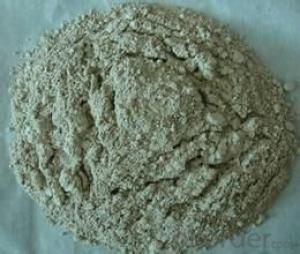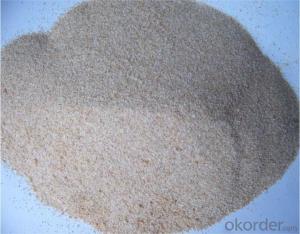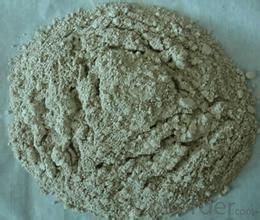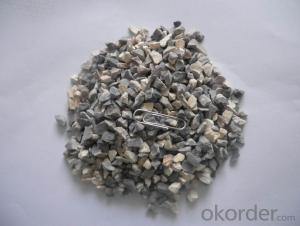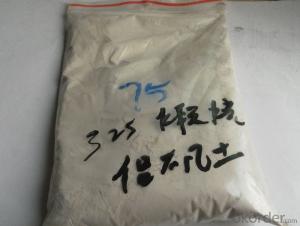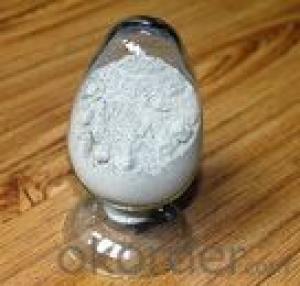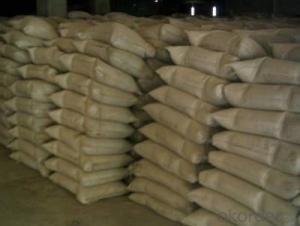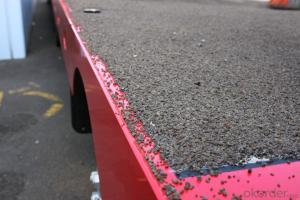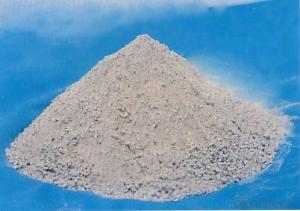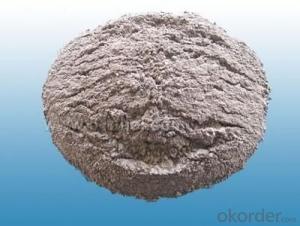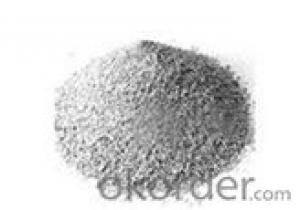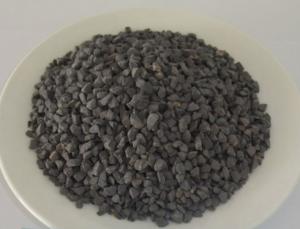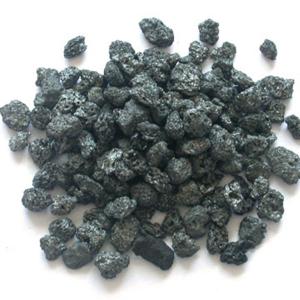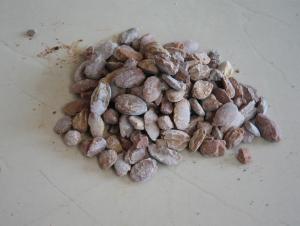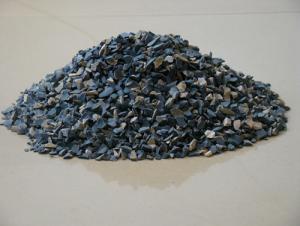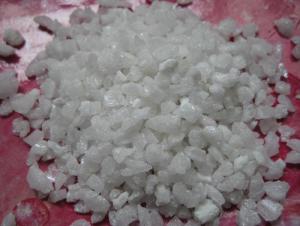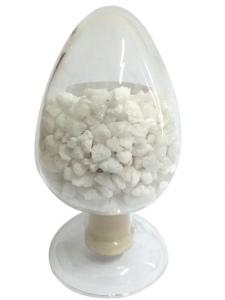Raw Materials for High Alumina Refractory Cement by CNBM
- Loading Port:
- China main port
- Payment Terms:
- TT OR LC
- Min Order Qty:
- 25 m.t.
- Supply Capability:
- 2000 m.t./month
OKorder Service Pledge
OKorder Financial Service
You Might Also Like
Description of High Alumina Refractory Cement
Products | Calcium Aluminate Cement /High Alumina Cement CA-50 |
Applications | 1,As binders calcium aluminates cement are used in concretes and mortars for specialised applications for their properties of resistance to corrosion, abrasion and heat combined with rapid hardening and the ease of controlling grading variations. with new properties are then obtained. In this way, aluminates act as both a complex hydraulic binder and a mineral reagent interacting with the other components in the mix. 2,As reagents, calcium aluminates are found in non-hydraulic systems. This is the case in metallurgical treatments (iron and steel industry, foundry) where specific grades of calcium aluminate are used for their low-temperature melting properties and for trapping molten metal impurities. |
Features | 1,Very low mixing-water requirement |
2,Very high purity | |
3,High product consistency | |
4,High cold and sintered strength | |
5,Very tight specifications of setting times |
product | CA50F | A600 | A700 | A900 | CA50R | ||
Chemical Compositionn (%) | SiO2 | ≤8.0 | ≤7.8 | ≤7.5 | ≤5.5 | ≤7.0 | |
Al2O3 | ≥50.0 | ≥50.0 | ≥51.0 | ≥53.5 | ≥52.0 | ||
Fe2O3 | ≤2.5 | ≤2.5 | ≤2.5 | ≤2.5 | ≤2.5 | ||
R2O | ≤0.4 | ≤0.4 | ≤0.4 | ≤0.4 | ≤0.4 | ||
S | ≤0.1 | ≤0.1 | ≤0.1 | ≤0.1 | ≤0.1 | ||
Cl | ≤0.1 | ≤0.1 | ≤0.1 | ≤0.1 | ≤0.1 | ||
45µm residue (%) | ≤20 | ≤15 | ≤12 | ≤8 | ≤8 | ||
Blaine (m2/kg) | ≥300 | ≥300 | ≥320 | ≥350 | ≥350 | ||
InitialSetting (min) | ≥30 | ≥45 | ≥60 | ≥90 | ≥30 | ||
FinalSetting (h) | ≤6 | ≤6 | ≤6 | ≤6 | ≤6 | ||
Flexural strength (MPa) | 6h | —— | —— | —— | —— | ≥3.0 | |
1d | ≥5.5 | ≥6.0 | ≥6.5 | ≥8.0 | ≥7.0 | ||
3d | ≥6.5 | ≥7.0 | ≥7.5 | ≥10.0 | ≥8.0 | ||
Compressive strength (MPa) | 6h | —— | —— | —— | —— | ≥30 | |
1d | ≥40 | ≥45 | ≥55 | ≥72 | ≥60 | ||
3d | ≥50 | ≥55 | ≥65 | ≥82 | ≥70 | ||
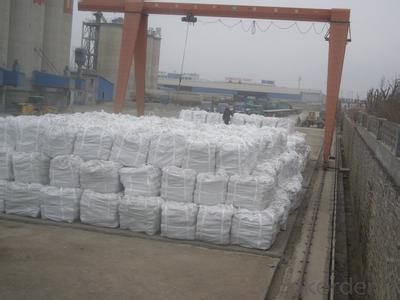
- Q: How to solve the shell, the crack problem of refractory material in the process of forming.
- Pressure mode and number of pressure control "spallation". 2, multiple pressure, pressure degree and discharge way: 1, reduce friction, choose appropriate, than big pressure disposable pressure produced by the plastic deformation, allocate reasonable grading, internal and external friction, reduce billet particles and high die wall bright. 4.--- solve the light one firstly. --moisture content being too high easily cause spallation - the compressibility of water is small and have certain elasticity, appropriately to extend the pressuring time is beneficial. The material can produce large plastic deformation under the effect of continuous load. The right amount of lubricant. - body under the condition of less pressure but long effect time molding. Mould structure is reasonable and improve billet natural stacking density. 5.3, measures to improve the unburned brick molding quality. Many times continuously pressure relief is better than one-off sudden unloading, and controlling the appropriate moisture content;- - is beneficial to air overflow.
- Q: Which are fire proofing thermal insulation materials?
- Grade-A fire proofing inorganic thermal insulation materials include rock wool, glass wool, vitrified micro bead, foaming cement, foaming ceramics, vacuum thermal insulation board,
- Q: Who knows about the criteria of fireproof and thermal insulation materials?
- Seven levels are divided according to "The classification of combustion performance of building materials and products", namely, A1, A2, B, C, D, E, F. It mainly refers to the combustion performance of materials. You can check on this standard for the specific dividing evidence. There are detail charts which mainly describe that whether there is drip or not, the ignition time, continuous burning time and so on.
- Q: What are the main components of refractory cement?
- Refractory cement, also known as aluminate cement, can also be gray. Aluminate cement is often yellow or brown. Aluminate cement takes bauxite and limestone as raw materials, alumina content of about 50% as the clinker. And it is a hydraulic cementing material made by grinding. The main mineral of aluminate cement is mono calcium aluminate (CaO · Al2O3, abbreviated CA) and other aluminates, and a small amount of dicalcium silicate (2CaO · SiO2), etc.
- Q: What material is used for making refractory stone bowl?
- It can be natural stone or synthetic material (referred to as synthetic stone). If chosen improperly, some natural stones will separate out the minerals which cause gastrointestinal discomfort on sensitive people. Synthetic material has great output with relatively high safety and it is stronger than ceramic casserole. Now stone pot of synthetic material is mainly used in South Korea.
- Q: What are the new types of refractories? What are the characteristics? Their applications and developments?
- AZS refractories are often used brick, corundum brick, magnesia chrome brick, silicon carbide, silicon nitride bonded silicon carbide, nitrides, silicides, sulfide, boride, carbide and other non oxide refractory materials; calcium oxide, chromium oxide, alumina, Magnesium Oxide, beryllium and other refractory materials.Often used insulation refractories are diatomite products, asbestos products, insulation panels and so on.Unshaped refractory materials commonly used are fettling, refractory ramming material, refractory castable, refractory plastic material, refractory clay, refractory gunning, refractory cast material, fireproof coating, lightweight castable, mud etc..
- Q: how to classify the fireproofing material levels A1 A2 B1?
- their classification is shown specifically in Fireproof? Specification of Building Interior Decoration?Design GB 50222-95 appendix A, flammability,inflammability materials, flame retardency, noninflammability: combustion performance of A, B3, B2, B1 materials are divided into
- Q: Pals who know something about fire resistant material please tell me how many types of refractory material there are
- Classified into ordinary and special refractories. The ordinary refractory material is calssified into acid, neutral and alkaline according to the chemical property. Special refractory material is calssified into high temperature oxide according to the composition for , infusible compound and high temperature composite in addition, can be divided into ordinary refractory products according to the fire intensity (1580 ~ 1770 DEG C), high-grade refractory products (1770 ~ 2000 DEG C) and special refractory products (2000 DEG C above). According to the products shape can be divided into bulk (standard brick, special-shaped brick block, special shape (crucible, sagger, pipe, etc), fibrous shape (silicates of aluminum and zirconium oxide and boron carbide matter) and irregular shape (fireclay, refractory castables and incompletely material).
- Q: Who knows what fire heat preservation material are there?
- Organic material, polystyrene board, plastic extruded board, phenolic resin. Sea capacity module (fire insulation materials fire performance can reach the B1 level, thermal conductivity is only 0.028w\m - K is a good choice, class A fireproof materials now is the mainstream rock wool (mineral wool is wool). A1 fire resistance The largest manufacturer is Thai stone rock wool Co. Ltd.
Send your message to us
Raw Materials for High Alumina Refractory Cement by CNBM
- Loading Port:
- China main port
- Payment Terms:
- TT OR LC
- Min Order Qty:
- 25 m.t.
- Supply Capability:
- 2000 m.t./month
OKorder Service Pledge
OKorder Financial Service
Similar products
Hot products
Hot Searches
Related keywords
